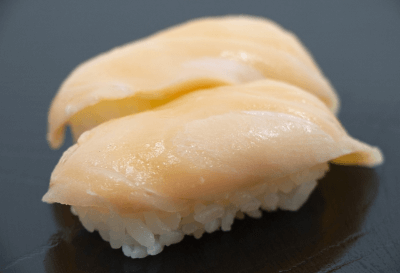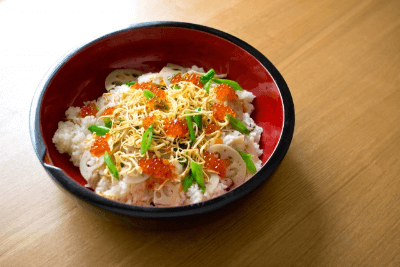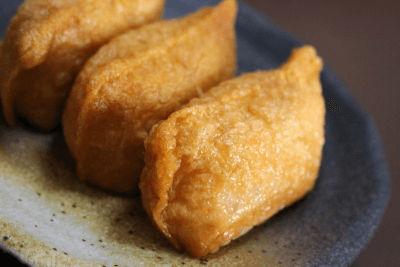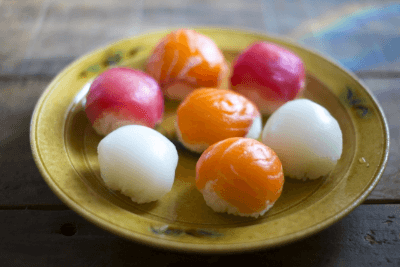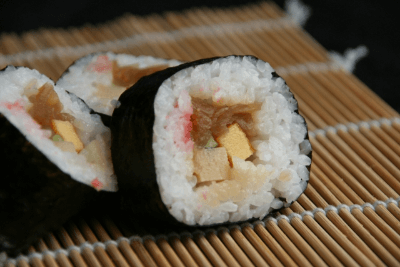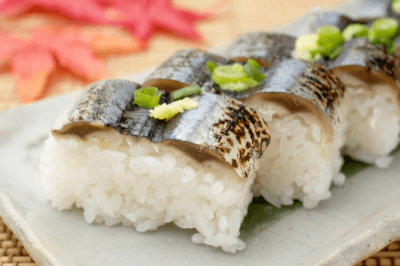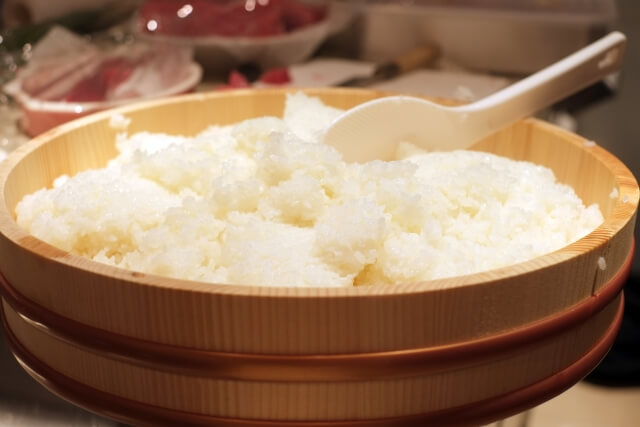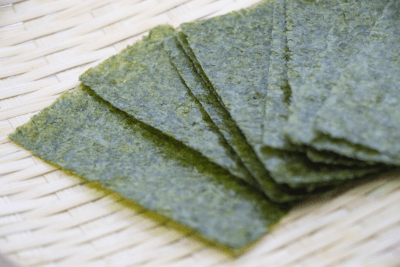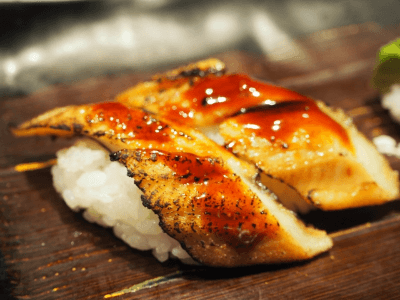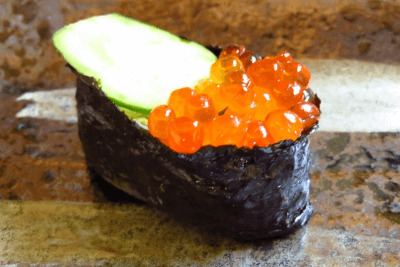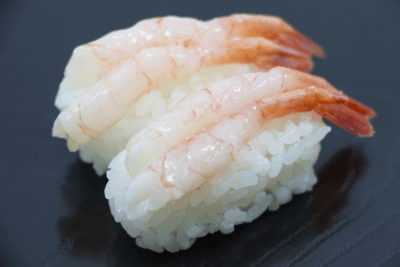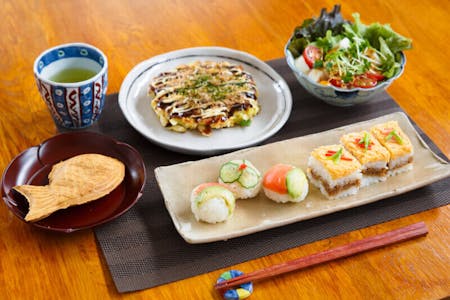

139 Cooking Classes in Kyoto
27 Classes in Kyoto
15 Classes in Kyoto
10 Classes in Kyoto
5 Classes in Kyoto
10 Classes in Kyoto
3 Classes in Kyoto
3 Classes in Kyoto
9 Classes in Kyoto
8 Classes in Kyoto
4 Classes in Kyoto
3 Classes in Kyoto
26 Classes in Kyoto
8 Classes in Kyoto
The beautiful serenity and scenery of Kyoto is the perfect setting to learn the art of sushi making. Round out your experience in the traditional and cultural hub of Japan with a class on how to make this traditional Japanese dish.
We had an amazing time getting detailed explanation on all the steps that go into making 3 amazing kinds of Sushi with Saturo & Akiko as very warm and welcoming hosts. Sadly we only had the lesson in the final days of our trip seeing as we would have loved to come back and to the Tempura & othe...
Nariko is a brilliant teacher, we learnt how to make the dough for Udon noodles, make sushi with salmon, cucumber and radish. We also prepared pickled cucumbers. Everything was very tasty. Nariko is very patient, explains the different steps clearly, her English is very good. We had a great time...
We had such a lovely time with Yukari, she was so organised and kind and the food was delicious. Exactly what we needed after many days eating out :)
We had a wonderful experience and learned a lot Don t hesitate, you love it and it s super close to Arashiyama so you can visit the area before or after
Thankyou Yukari for such a fabulouw learning experience with your step by step instructions of making okonomiyaki and sushi . We thoroughly enjoyed the what and how to make these delicious dishes. Yukari was so knowledgeable and her experience shone through. It was one of our absolute highlights ...
Homemade Sushi and Okonomiyaki is popular with other travelers visiting Kyoto.
Some of the best sushi making classes for vegans in Kyoto include Vegan Sushi Class (two people or more).
All sushi making classes in Kyoto on airKitchen are offered in English.
Popular cheap sushi making classes in Kyoto include Experience making authentic sushi with a professional.
On average sushi making classes in Kyoto cost ¥10232 per person (based on airKitchen prices).
Please note that this is an example, and classes vary by host.
Sushi meshi, or sushi rice, is made by combining freshly cooked rice with vinegar, sugar, and salt.
Sushi neta refers to the sushi toppings, mostly commonly sashimi, seafood, and egg for nigiri sushi. Depending on the ingredients, different preparations are needed.
Nothing compares to freshly grated wasabi from the wasabi rhizome. (Within minutes, wasabi begins losing its nuanced flavor!)
Using wetted hands and fingers, shape the rice into rectangular or oval blocks.
Now that the rice, sushi neta, and wasabi are prepared, you can assemble your nigiri sushi! The wasabi is often used to help stick the toppings to the rice.
Now you can dig in with a little soy sauce and wasabi!
Cooked rice is combined with vinegar, sugar, and salt to create the distinct flavor of sushi meshi (sushi rice).
There are a wide array of possibilities when it comes to ingredients for maki sushi. Sashimi, seafood, egg, and both fresh and pickled vegetables are more traditional options.
To start assembling your roll, you'll have to spread a layer of rice on a sheet of nori (seaweed).
Then, the sushi ingredients are added in the middle on top of the rice.
This can be tricky, but gets easier as you get the hang of it! Using a wooden sushi mat, roll up the seaweed and fillings into a cylinder.
All that's left is slicing up the elongated roll into the familiar, smaller sushi rolls. A moistened knife will help with clean cuts.
Now you can dig in with a little soy sauce and wasabi!
Combine cooked rice with vinegar, sugar, and salt in order to make sushi rice.
You can use a variety of ingredients when making temari sushi. Fish, seafood, meat, and vegetables, both raw and cooked, are all common. It's recommended to thinly slice your toppings for the best results.
After first placing the topping(s) on a sheet of plastic wrap, add a little wasabi (if you'd like) and a small amount of rice.
Wrap and twist the plastic wrap around the ingredients to form a perfect sphere. With the plastic wrap to guide you and keep your hands clean, it won't be too difficult to make an evenly-shaped ball!
Your first temari sushi is done! Experiment with mixing and layering different colors and textures of ingredients for an attractive temari sushi set.
To make a batch of sushi rice, add vinegar, sugar, and salt to cooked rice.
Chirashi sushi toppings vary widely by region and taste in Japan. Raw fish, egg, cooked and uncooked seafood and vegetables, and other colorful garnishes are popular options.
Ingredients can be mixed in directly with the sushi rice, placed on top, or a combination of the two. Add colorful garnishes at the end to give your chirashi sushi bowl an attractive appearance.
With your sushi rice and ingredients now all together, your chirashi sushi is ready to be enjoyed!
Fold vinegar, salt, and sugar into cooked rice to make sweet sushi rice.
Aburaage is deep-fried tofu that forms the outside pockets of inari sushi. In order to prepare it, you'll simmer the inari in a broth typically made of dashi, sugar, and soy sauce.
Using your hands, mold cylindrical balls of sushi rice.
Pack the rice balls into the aburaage pouches, sealing them as you finish. Lastly, if you'd like, sprinkle on black sesame seeds as a garnish.
Enjoy your simple and sweet inari sushi treat!
Together, cooked rice, vinegar, sugar, and salt make up the foundation of sushi rice.
Pickled fish and vegetables are popular toppings for oshi sushi. They'll need to be cut in a way that they fit in the oshibako – the wooden frame that the oshi sushi is pressed in.
With hands and oshibako moistened with vinegar water, you're ready to assemble your oshi sushi! Start with adding layer of your sushi topping to the base of the oshibako, then add rice on top.
In order to achieve the distinct pressed style of oshi sushi, you'll place the top press of the oshibako on top of the rice and push down firmly.
Slide the resulting long rectangular strip out of the oshibako. With the ingredients on top, slice into bite-sized pieces of sushi.
Time to eat your tasty oshi sushi!
Different types of sushi evolved throughout the various regions of Japan. Differing cultures, tastes, and ingredients influenced these distinct sushi styles, which continue to change and expand today. See More About Sushi
Typically composed of sushi rice with thinly sliced raw fish atop, nigiri sushi is simple and elegant. Shellfish and egg are other common nigiri sushi toppings.
See More About Nigiri Sushi
Chirashi sushi gets its name from the Japanese word "chirashi", meaning "scattered". Ingredients are mixed in and topped on sushi rice in a bowl.
See More About Chirashi Sushi
A sweeter option than others, inari sushi refers to sushi rice that has been wrapped in a flavorful pouch of aburaage (deep-fried tofu).
See More About Inari Sushi
Temari sushi is simple to make and thus a popular option for home cooking. Sushi rice is formed into spheres with ingredients placed on top, often decoratively.
Perhaps the most recognizable, maki sushi consists of sushi rice and ingredients delicately rolled in a sheet of seaweed that is then cut into smaller slices.
See More About Maki Sushi
Also knows as hako sushi, oshi sushi is distinguished by its shape. It is formed by pressing sushi rice and toppings into a rectangular "oshiwaku" box before being cut into angular blocks or triangles
Rice seasoned with vinegar, sugar and salt
See More About Sushi Meshi
Seaweed
Fatty tuna
See More About Toro
Conger eel
See More About Anago
Salmon roe
See More About Ikura
Sweet shrimp
See More About Ama-Ebi
Sea urchin
See More About Uni
People often travel to Kyoto to experience the history and tradition of Japan, which includes enjoying traditional Japanese cuisine. Sushi holds great historical and cultural significance in Japan, with various styles evolving depending on regional and cultural differences. While in Kyoto, a perfect way to enjoy and immerse yourself in Japanese culture is through learning how to make your own sushi with a Japanese host.
The opportunity to learn how to make sushi directly from a Japanese local in their own home is rare. Through an airKitchen sushi making class, you’ll get to peek into what daily life in Kyoto looks like for the city’s inhabitants, as well as participate in meaningful cultural exchange across national and cultural boundaries. After finishing making your sushi, you’ll sit down and enjoy your meal with your Japanese host.
With the help of your Japanese host, you’ll possess the skills to make your own authentic, tasty sushi after your cooking class. Continuing to make sushi is a great way to preserve memories of your travels to Kyoto and share your experience in Japan with your loved ones at home.




























